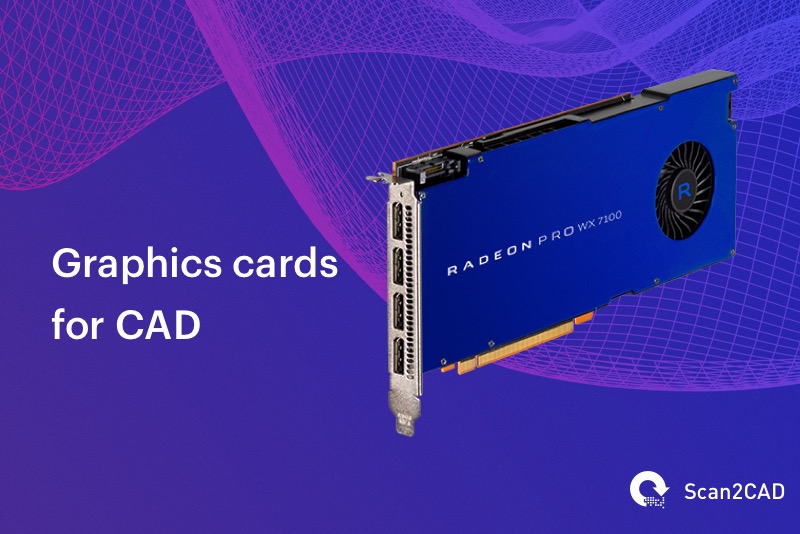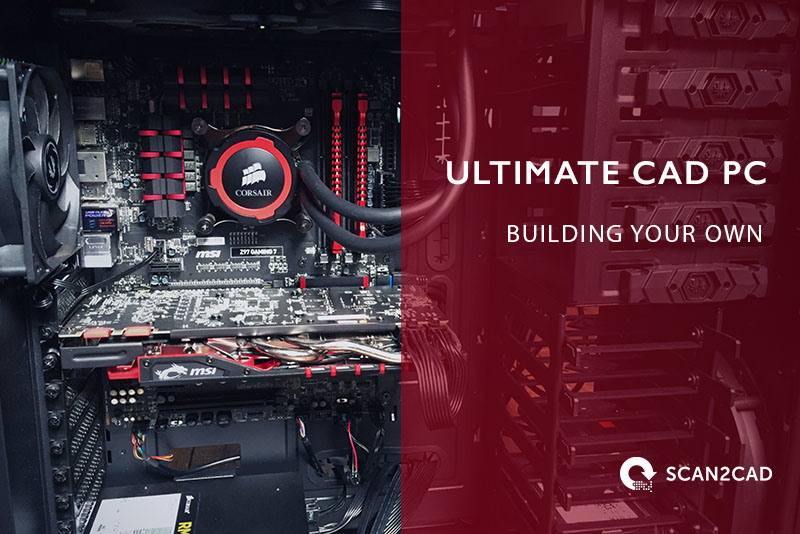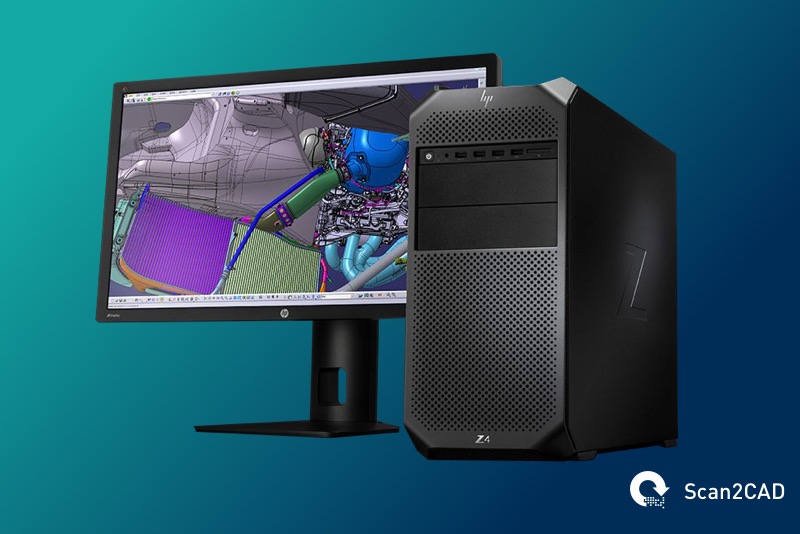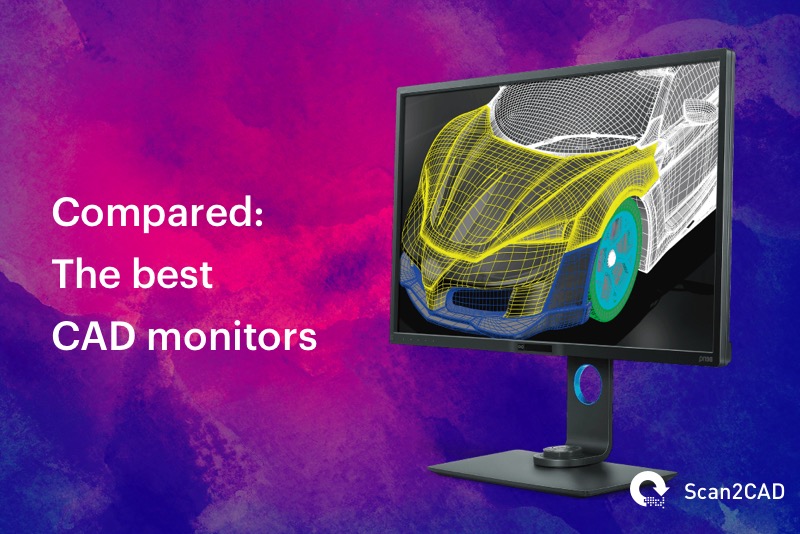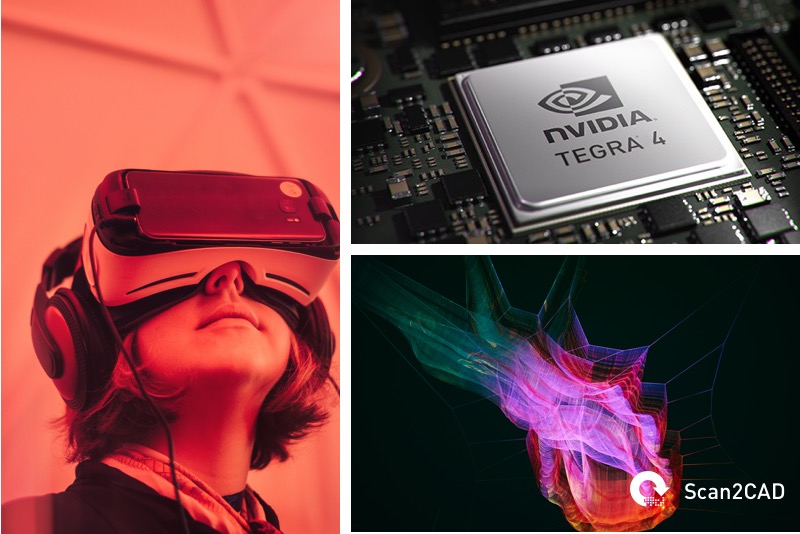So, you’ve decided you need to purchase a graphics card for your CAD work. At first, you may have thought that you could purchase any graphics card as long as it is powerful—only to realize that the GPU market is more complex than that!
That’s why we’ve created this post as the ultimate reference for purchasing new graphics cards for CAD. We’ll walk you through what you need to know and end with our top 5 picks on the market right now.
Table of Contents
Is Nvidia leading the pack with graphics card development?
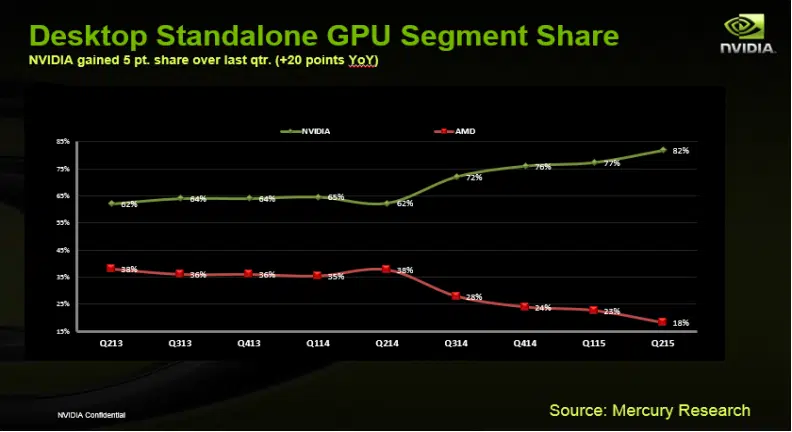
Comparing Nvidia’s vs. AMD’s market share for the PC graphics card market in 2013 to 2015. Source.
For a long time, in recent history, the short answer to this question would be ‘yes’. There is little doubt that if you’re comparing graphics card options, an Nvidia product will be on the shortlist. If comparing market-share alone, Nvidia is the dominant brand. Their strategy has been to focus purely on GPU technology by partnering with Intel for their CPU requirements. In comparison, AMD directly competes in both markets by producing CPUs and GPUs.
Nvidia also provides the chips for many graphics card manufacturers who could be classed as their competitors, but, in reality, are their partners. See our list of graphics card manufacturers for an insight into Nvidia’s stronghold in the market.
However, this doesn’t mean you should skip the rest of this guide and purchase an Nvidia card. The market is more nuanced than that.
Nvidia’s domination has forced companies such as AMD to focus on solutions for specific user requirements—CAD being one of them. And, in many like-for-like comparisons, AMD has come out on top for certain uses. This muddies the water and justifies a lengthy post on the best graphics cards for CAD. So, let’s delve in!
And as I’ve updating this post over the years, I have seen how AMD have set a standard for high-spec CAD graphics cards such as those compared later in this article.
What do the model numbers on graphics cards mean?

You have probably noticed that many graphics cards have a number in their product names. Let’s look at the below table showing 4 graphics cards from 4 different manufacturers, all of which use the same number in their model name.
|
Manufacturer |
Model Name |
Further Details |
|---|---|---|
|
Asus |
GeForce GTX 1080 |
|
|
EVGA |
GeForce GTX 1080 |
|
|
Gigabyte |
GeForce GTX 1080 |
|
|
MSI |
GeForce GTX 1080 |
So, why do all these cards reference the same model number? In the above list, all products are using the same GPU produced by Nvidia: the Nvidia 1080 GPU. Therefore, they use the same model number to inform the users of what’s under the hood.
Many brands will use the GPU chips of the market leaders, packaged in their solution. This gives smaller graphics card manufacturers the option not to compete with Nvidia or AMD on-chip performance, but instead to offer their customers another option in how it is presented.
Some companies may simply offer a preferable cooling system to that of Nvidia. Meanwhile, the GTX 1080 by Gigabyte, for example, uses Nvidia’s GTX technology but is unique in being much smaller in overall footprint than the Nvidia equivalent.
Do higher graphic card model numbers mean better performance?
If purchasing a motorcycle, we would know that a 700cc engine is more powerful than a 300cc engine. The cubic centimeters measurement can’t be gamed; the engine is either the stated volume or it isn’t. Unfortunately, the numbers used in most GPU model names do not relate to any real-world measurement.
As the Logical Increments blog explains, it isn’t always as simple as a higher model number being faster than other lower model numbers. For example, Nvidia’s GTX 680 is faster than the GTX 760 as it has ‘“more raw performance” than the 760.’ Confused? Don’t worry, you’re not the only one.
These numbers should be thought of as nothing more than part of the product name, which in some cases identifies the GPU being used.
Therefore, this is a case of buyer beware! Do not assume that the number indicates the same specifications as other manufacturers. Always carefully read the specifications of the graphics card you’re considering.
Gaming graphics cards for CAD
The popularity of gaming graphics cards is difficult to ignore. However, whilst they often come with impressive specs, there are several key factors that differentiate them from workstation graphics cards for CAD. We’ll take a quick look at why they have become so prominent, and the reasons why they may not be a great choice for CAD.
Why are there so many gaming graphics cards?
You will notice that many of the brands you come across will have a prominent offering of gaming-focused graphics cards. This is a simple case of supply and demand; it is an indication of gaming is the highest growth market in GPU sales.
In 2017 Nvidia increased its revenue from gaming products by 49% compared to 2016. They now take roughly $1 billion in sales per year purely from gaming GPUs.
Due to the growth in eSports and the interest in Virtual Reality gaming, the prominence of gaming graphics cards is unlikely to be a fad.
Moreover, this growth in gaming graphics cards should be considered good news for any GPU shopper. With massive investment in R&D and tight competition between manufacturers, the improvements in GPU technology are beneficial for gamers and CAD users alike.
Could I use a gaming graphics card for CAD?
Yes and no. You can use a gaming graphics card for CAD work but be warned that not all gaming graphics cards will be suitable. Software such as SolidWorks, for example, will typically only work well with an Nvidia Quadro or AMD FirePro card.
If you need a GPU suitable for both gaming and CAD, the ideal solution would be to have a separate gaming machine from your CAD machine. For many users, however, this simply isn’t practical. Unfortunately, though, graphics cards specifically designed for CAD do not tend to be suitable for the required rendering in gaming.
The better path to follow is to research which gaming graphics cards have been reported to work well with your CAD software.
For example, the Asus Strix GTX 1070 reportedly works well with AutoCAD—and it is also fantastic for shooting zombies.
I can tell you that my graphics card of choice, Nvidia’s Quadro K1200, has been a great CAD graphics card, but it would not be able to handle relatively simple 3D games.
Will my graphics card be ‘future-proof’?
The definition of ‘future-proof’ is a piece of technology that is ‘unlikely to become obsolete’. Therefore, this question is subjective. Whether or not you consider your graphics card to be obsolete will be dependent on how you wish to use it.
For example, a 10-year-old graphics card may still be fantastic at browsing the web, but perhaps not so great if you wish to do anything graphically strenuous.
When it comes to ensuring your CAD PC is as future-proof as it can be, the best advice is to purchase the best model you can afford. The higher the specifications, the longer the GPU is likely to serve you.
Graphics cards benchmarks and why they matter
Our guide on graphics cards wouldn’t be complete if we didn’t mention benchmarks. Benchmarks are automated tests run by specially designed software. This software will perform specific tasks whilst measuring the performance and workload of the GPU.
These benchmarks are important because they avert subjective discussions on the best graphics card for a particular use. Instead, you can find empirical data on a GPU’s performance. You can even run a benchmark yourself thanks to software available from Cadalyst.
Benchmark tests can regularly highlight surprising results. Tom’s IT Pro ran benchmark tests on Nvidia’s Quadro M6000 graphics card. They found that whilst the M6000 outperformed competitors for 3D rendering, the same GPU came third for 2D rendering. These results are demonstrated in the below charts.
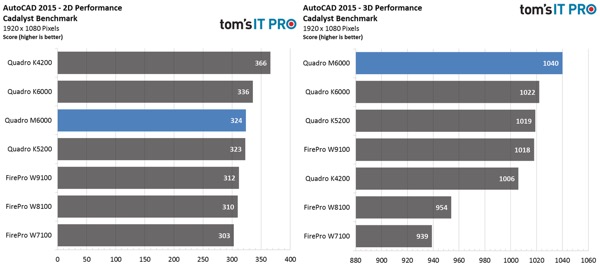
Benchmark test results for the Nvidia Quadro M6000 with 2D and 3D AutoCAD rendering. Source: tomsitpro.com.
Certified graphics cards for CAD
A number of the most prominent software developers have made life easier for us by publishing their list of graphics cards that have been tried and tested with popular CAD software. These are often referred to as ‘certified devices’ by the software developer.
If the graphics card you’re considering is supported by the software you intend to use, you will have much more confidence with your purchase.
We’ve collected a list of these published certified devices below.
|
Software |
Developer |
Certified Devices |
|---|---|---|
|
Ansys |
Ansys Inc |
|
|
ArchiCAD |
Graphisoft |
|
|
AutoCAD |
Autodesk |
|
|
Bentley MicroStation |
Bentley |
|
|
CATIA |
Dassault Systèmes |
|
|
Chief Architect |
Chief Architect, Inc. |
|
|
Creo |
PTC |
|
|
FreeCAD |
Open source |
|
|
Inventor |
Autodesk |
|
|
Revit |
Autodesk |
|
|
Siemens PLM |
Siemens |
|
|
SolidWorks |
Dassault Systèmes |
Are we missing software that you’d like to see? Let us know in the comments.
Note: FreeCAD does not have their own list of specific model recommendations but their software is based on OpenGL. Therefore, we have linked to the OpenGL supported devices from Nvida.
Don’t neglect the rest of your PC
There will be little point in investing in your ideal graphics card if the rest of your PC isn’t suitable for the required workload.
We created a popular post on how to build the ultimate CAD PC, in which you’ll find tips on what to consider when shopping for all PC components. It can take some time to research compatibility with all your PC’s components but the extra work is worthwhile.
Comparison: Our top graphics cards for CAD
So, here’s our pick of the bunch. We’ve chosen to make a shortlist of graphics cards that would be suitable for both 2D and 3D CAD work. As a way of stating their suitability, we have referenced whether they are suitable for AutoCAD (2D) and SolidWorks (3D). We have sourced their statement of suitability from the official hardware recommendations of AutoCAD and SolidWorks.
We assume that you’re not too concerned about support for technology such as virtual reality. This isn’t yet a widely accepted requirement in CAD, but I’m sure we will need to update this article in a few years to account for that.
We have also tried not to go too high on the pricing scale whilst still focusing on professional-grade options. All options are below $1,000. Yes, you could purchase a phenomenal graphics card for $4,000, but adding that option to our comparison wouldn’t help most readers and it would be overkill for 99% of CAD work. And remember, whilst we give a rough guide for the price of each option, there are various specifications within each option which can increase or decrease the price.
We have also created separate lists for the top GPU manufacturers, AMD and Nvidia. Therefore if you are loyal to a specific brand, you have direct comparisons for their best options.
To finish off, we have combined what we think are the best Nvidia and AMD options overall.
Comparison: The top AMD graphics cards for CAD

Here are the best AMD graphics cards for CAD
| Product | Suitable for AutoCAD (2D)? | Suitable for SolidWorks (3D)? | Price | Availability |
|---|---|---|---|---|
| AMD Radeon Pro WX 3200 | Yes | Yes | ~ $220.00 | → Check availability on Amazon |
| AMD Radeon Pro WX 3100 | Yes | Yes | ~ $470.00 | → Check availability on Amazon |
| AMD Radeon Pro W5500 | Yes | Yes | ~ $490.00 | → Check availability on Amazon |
| AMD Radeon Pro WX 5100 | Yes | Yes | ~ $650.00 | → Check availability on Amazon |
| AMD Radeon Pro W5700 | Yes | Yes | ~ $930.00 | → Check availability on Amazon |
Comparison: The top Nvidia graphics cards for CAD

Here are the best Nvidia graphics cards for CAD:
| Product | Suitable for AutoCAD (2D)? | Suitable for SolidWorks (3D)? | Price | Availability |
|---|---|---|---|---|
| NVIDIA Quadro P600 | Yes | Yes | ~ $180.00 | → Check availability on Amazon |
| NVIDIA T600 | Yes | Yes | ~ $210.00 | → Check availability on Amazon |
| NVIDIA Quadro M2000 | Yes | Yes | ~ $250.00 | → Check availability on Amazon |
| NVIDIA T1000 | Yes | Yes | ~ $380.00 | → Check availability on Amazon |
| NVIDIA Quadro P2200 | Yes | Yes | ~ $700.00 | → Check availability on Amazon |
Comparison: The top 5 graphics cards for CAD

At this point, you’ve seen our best picks from the individual GPU manufacturers. To finish up, here are our top picks from AMD and Nvidia combined.
Here are the best graphics cards for CAD
Be sure to check the detailed descriptions for each option below the list to learn more about our selections.
Quick comparison chart
In order of ascending average price.
| Product | Suitable for AutoCAD (2D)? | Suitable for SolidWorks (3D)? | Price | Availability |
|---|---|---|---|---|
| Nvidia Quadro P600 | Yes | Yes | ~ $180.00 | → Check availability on Amazon |
| AMD Radeon Pro WX 3200 | Yes | Yes | ~ $220.00 | → Check availability on Amazon |
| Nvidia T1000 | Yes | Yes | ~ $380.00 | → Check availability on Amazon |
| AMD Radeon Pro W5500 | Yes | Yes | ~ $490.00 | → Check availability on Amazon |
| AMD Radeon Pro WX 5100 | Yes | Yes | ~ $650.00 | → Check availability on Amazon |
Nvidia Quadro P600

Kicking off with a budget choice for CAD users, Nvidia’s Quadro range is known to work solidly for most CAD applications. Reportedly, Dassault Systèmes design the graphic rendering of SolidWorks with Quadro graphic cards in mind. The P600 is not the highest spec model in the range, as such you should consider its suitability for heavy CAD rendering (although the P600 is cetified by for SolidWorks). But if working solely in 2D drafting, this should be suitable choice.
|
GPU Manufacturer |
Nvidia |
|---|---|
|
Suitable for AutoCAD (2D)? |
Yes (According to Autodesk) |
|
Suitable for SolidWorks (3D)? |
Yes (According to SolidWorks) |
|
Price |
~ $180.00 |
|
Availability |
→ Check availability on Amazon |
AMD Radeon Pro WX 3200

AMD acquired the Radeon GPU technology from ATI Technologies in 2006. Since the acquisition, the Radeon range has played an integral part in AMD’s GPU market growth.
The Radeon Pro WX 3200 comes in at just over $200 (dependent on the specification you choose) and offers great performance for the relatively low price.
|
GPU Manufacturer |
AMD |
|---|---|
|
Suitable for AutoCAD (2D)? |
Yes (According to Autodesk) |
|
Suitable for SolidWorks (3D)? |
Yes (According to SolidWorks) |
|
Price |
~ $220.00 |
|
Availability |
Nvidia T1000

Although this graphics card is named as though it’s the next Terminator, it’s not going to ask for your clothes, boots and motorcycle. The T100 is described by Nvidia as being ‘power and performance in a small form factor’. As with all options presented in this article, the T1000 is certified by the respective developers for use with AutoCAD and Solidworks.
|
GPU Manufacturer |
Nvidia |
|---|---|
|
Suitable for AutoCAD (2D)? |
Yes (According to Autodesk) |
|
Suitable for SolidWorks (3D)? |
Yes (According to SolidWorks) |
|
Price |
~ $380.00 |
|
Availability |
AMD Radeon Pro W5500

For our fourth graphics card, we bring you another great option from AMD’s Radeon range. The Radeon Pro W5500 comes at a higher average price to the Radeon Pro WX 3200 (depending on the specification you might choose). AMD boasts the W5500 as superior to Nvidia’s Quadro P2200 for power efficiency when running AutoCAD or SolidWorks.
|
GPU Manufacturer |
AMD |
|---|---|
|
Suitable for AutoCAD (2D)? |
Yes (According to Autodesk) |
|
Suitable for SolidWorks (3D)? |
Yes (According to SolidWorks) |
|
Price |
~ $490.00 |
|
Availability |
AMD Radeon Pro WX 5100

We end our list of top 5 graphics cards for CAD with the highest-priced, yet still very budget-friendly, Radeon Pro WX 5100 from AMD. The WX 5100 offers some impressive specifications which are reported to serve graphic-heavy CAD applications smoothly.
And for those running OpenGL-powered applications, such as FreeCAD, AMD lists the WX 5100 as having ‘comprehensive support’ for these graphic technologies.
|
GPU Manufacturer |
AMD |
|---|---|
|
Suitable for AutoCAD (2D)? |
Yes (According to Autodesk) |
|
Suitable for SolidWorks (3D)? |
Yes (According to SolidWorks) |
|
Price |
~ $650.00 |
|
Availability |
Bonus: List of graphics card brands
We’ve collected a list of the most popular graphics card manufacturers. You may not have heard of many of these brands, but some of these lesser-known names are producing impressive products.
Conclusion
When choosing a graphics card for CAD, first consider the specific list of applications you will use in your CAD work. From there, you can quite easily narrow-down a list of graphics cards which would be suitable for your CAD work by looking at the list of certified GPUs recommended by the software developers.
Most importantly, as mentioned earlier, don’t assume that one good graphics cards will be suitable for all types of graphics rendering.
If you’re unsure which models to choose, I’m confident the above list will be a big help to you. Both NVIDIA and AMD have some great options for under $1,000, for example AMD’s Radeon Pro WX 3200 and NVIDIA’s T1000 are both under $500 and have been officially certified for use with SolidWorks and AutoCAD. If you are able to significantly increase your budget, AMD’s Radeon Pro W5700 at ~ $930.00 packs a real punch for relatively heavy CAD 3D rendering.

